History of offshore wind energy
Discovering the evolution and impact of offshore wind energy
Offshore wind Renewable energy
Today, offshore wind energy is a key sustainable alternative to fossil fuels. But have you ever wondered about the origins of the technology? Let’s travel back in time to explore the complex history of this renewable energy source, its technological evolution and its expansion around the world.
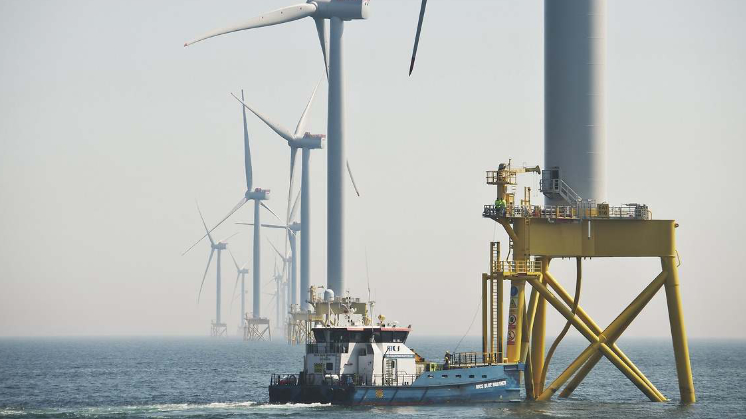

The history of offshore energy is the result of a series of major innovations and technological developments that have been improving the efficiency and capacity of its parks.
A few decades ago, the idea of harnessing the forces of nature with offshore wind turbine clusters was unthinkable and could have even been the plot of a science fiction story. Many years, many trials and errors later, the scene is more than a reality: offshore energy is an efficient alternative for a sustainable future. Let’s take a look at the origins of offshore wind, its expansion around the world and the evolution of its capacity throughout history.
History of Offshore Wind Energy
Early experiments in offshore wind energy have little to do with the global energy production we conceive of today. The truth is that humans have been using this technology since ancient times, albeit with simpler mechanisms and for more limited applications. Historical research suggests that various civilisations such as the Egyptians, Greeks and Romans were already using, to a greater or lesser extent, offshore wind energy, in sailboats to harness the power of the wind as they travelled across lakes, seas and oceans, for example.
Ancient Mediterranean and Asian civilisations are also known to have used windmills to grind grain and pump water. These installations were similar to those used on land, but it is thought that they may have been located in areas close to large bodies of water, where sea winds are stronger and more constant.
These early forms of harnessing the wind were much simpler than modern technologies, as today's offshore wind energy involves the design and construction of wind turbines and other infrastructure specifically designed for large-scale electricity generation. Nevertheless, they set the precedent.
Origins of offshore wind energy
The more specialised development of this technology began in earnest in the second half of the 20th century in Europe, specifically in Denmark, the Netherlands and the United Kingdom, which became pioneers in wind turbines in near-shore waters to harness the wind from the sea. But what motivated the shift of energy generation from land to sea? There are three fundamental reasons for installing them in large bodies of water:
In these circumstances and after the first experiments, the definitive push for offshore wind energy came in the last three decades of the 20th century. The oil crisis of 1973 made it necessary to promote different energy sources to diversify supply, which led researchers from all over the world to work on alternatives such as offshore wind energy in the 1980s and 1990s.
Innovations and technological developments
This development of offshore wind energy would not have been possible without a series of innovations and technological developments that boosted the efficiency and capacity of offshore wind farms. The industry continues to promote improvements to harness the full potential of the seas and oceans for energy. So far, the most significant advances have focused on three key areas:
Evolution of foundations in offshore wind farms
One of the key technical drivers has been the evolution of foundations in offshore wind farms. This improvement aims to help adapt installations to a wide variety of offshore conditions and to increase projects’ efficiency and stability. Wind farms are increasingly being installed further offshore and at greater depths to prevent them having a visual impact and to take better advantage of strong offshore winds. To achieve this, a wide variety of foundations have been developed, including monopile, gravity and jacket types.
The most recent innovation is floating foundations, which allow turbines to be installed on the surface of the water, anchored to the seabed by mooring lines. This technology has made it possible to install structures where previously it was impossible.
Global expansion of offshore wind energy
The accelerated growth of offshore wind has also been driven by a combination of climate commitments, national energy policies and regulatory measures that have put the focus on the need for an energy transition. Some of the main factors are:
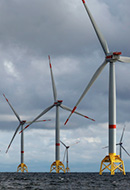
What is offshore wind energy
Do you know how offshore wind farms work?
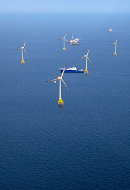
Relevant terms
Find out the ten most relevant terms of offshore wind power with Iberdrola.
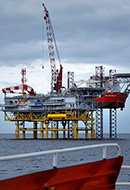
Construction of an offshore wind plant
Everything you'd like to know about offshore wind farm construction.
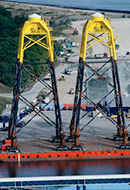
Offshore wind turbines foundations
How are offshore wind turbines anchored at sea?
Evolution of the energy capacity obtained
With these technical, political and social factors, significant improvements in offshore energy production have been achieved. Growth has been unstoppable. Data from organisations such as the International Energy Agency (IEA) Enlace externo, se abre en ventana nueva. attest to this: the world's installed capacity of offshore energy has increased from 100 MW in 2001 to 73.6 GW in 2024. At Iberdrola we have also experienced this evolution: at West of Duddon Sands - our first facility of this kind - each wind turbine produced 3.8 MW in 2014, while Windanker will have 15 MW wind turbines. In just a decade, the size of the wind turbines we install has increased fourfold.
Enlace externo, se abre en ventana nueva. attest to this: the world's installed capacity of offshore energy has increased from 100 MW in 2001 to 73.6 GW in 2024. At Iberdrola we have also experienced this evolution: at West of Duddon Sands - our first facility of this kind - each wind turbine produced 3.8 MW in 2014, while Windanker will have 15 MW wind turbines. In just a decade, the size of the wind turbines we install has increased fourfold.
The trend also points to exponential future growth relative to other renewable technologies. Land scarcity in some regions driving renewable production may limit the construction of solar and onshore wind power plants despite the strength of these technologies worldwide - with more than 2,300 GW of photovoltaic distribution systems and more than 1,700 GW of onshore power by 2024, according to the IEA. Bloomberg notes in its New Energy Outlook 2024 Enlace externo, se abre en ventana nueva. report that countries such as South Korea, Vietnam and Japan are likely to encounter this problem in the Net Zero scenario established by the international community to achieve global carbon neutrality by 2050.
Enlace externo, se abre en ventana nueva. report that countries such as South Korea, Vietnam and Japan are likely to encounter this problem in the Net Zero scenario established by the international community to achieve global carbon neutrality by 2050.
While the US agency notes that "there is still plenty of room for renewable energy growth in all geographic areas", it stresses that "a greater share of less land-intensive technologies, such as offshore wind, will be needed in the future".
Global cumulative offshore wind capacity in operation (in MW)
 SEE INFOGRAPHIC: Global cumulative offshore wind capacity in operation (in MW) [PDF]
SEE INFOGRAPHIC: Global cumulative offshore wind capacity in operation (in MW) [PDF]
Future of offshore wind energy
Climate commitments and decarbonisation targets will continue to drive the deployment of renewable energy around the world. World leaders are working towards the goal of tripling the world's installed renewable energy capacity by 2030, and fast-growing offshore wind technology is set to be a key player in transforming countries' energy matrices.
The Global Wind Energy Council estimates in its Global Offshore Wind Report 2024 External link, opens in new window. that deploying this technology will be in line with global targets of 380 GW by 2030 and warns of the need to maintain the "current political momentum". The organisation also points out that the next driving wave of this type of renewable energy will develop exponentially in regions such as Asia-Pacific, Latin America and Europe, where this technology is being adopted "as a solution to supply clean and affordable energy to their citizens and industries". The International Energy Agency (IEA) insists in its World Energy Outlook 2023
External link, opens in new window. that deploying this technology will be in line with global targets of 380 GW by 2030 and warns of the need to maintain the "current political momentum". The organisation also points out that the next driving wave of this type of renewable energy will develop exponentially in regions such as Asia-Pacific, Latin America and Europe, where this technology is being adopted "as a solution to supply clean and affordable energy to their citizens and industries". The International Energy Agency (IEA) insists in its World Energy Outlook 2023 External link, opens in new window. report on the need to invest up to three times more in new offshore projects and forecasts rapid growth in the technology, especially from 2030 onwards.
External link, opens in new window. report on the need to invest up to three times more in new offshore projects and forecasts rapid growth in the technology, especially from 2030 onwards.
This will lead to an increase in each turbine’s installed capacity. Estimates are imprecise, but some organisations, such as Bloomberg, IEA or the Global Wind Energy Council point to over 20 MW per turbine by 2030. Another key trend of the future will be the push for floating wind power. Until recently, traditional offshore wind farms, being based on fixed structures, could not be installed in very deep or at complex seabed locations, but this has changed with the advent of floating structures. And the trend is set to increase, opening up new opportunities for this technology: Kings Research estimates that the floating offshore wind market will reach $17.44 B by 2030.
Our offshore wind projects
Offshore wind is key to Iberdrola's future growth and to our commitment to the energy transition. Two decades ago, we were pioneers in the development of onshore wind energy, and now we are also pioneers in offshore wind, one of our major growth vectors. Our main facilities include:
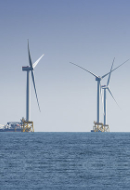
East Anglia Hub complex
Our biggest offshore wind project worldwide.

Kitty Hawk farm
3,500 MW of clean energy thanks to offshore winds.
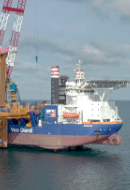
Saint-Brieuc farm
Iberdrola's first large-scale offshore wind power project in Brittany.
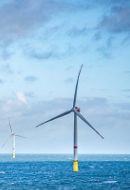
Vineyard Wind I farm
Our first offshore wind farm in the United States.
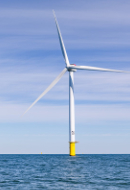
New England Wind 1 farm
Our second wind farm off the coast of Massachusetts.
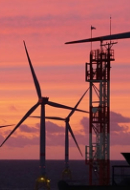
Baltic Eagle farm
Our second large offshore wind farm in Germany.
With a strong project pipeline, we opted for a focused investment in offshore wind in the United States, the United Kingdom, France and Germany. In this way, we are making sure we meet our strategic plan and are looking for new growth opportunities.
UK
- East Anglia ONE In operation - 714 MW
- West of Duddon Sands In operation - 194 MW
- East Anglia THREE In construction - 1,4 GW
- East Anglia TWO In construction - 960 MW
- East Anglia ONE North In development - 760 GW
- Scotwind In development - 7 GW
France
- St. Brieuc In operation 496 MW
Sweden
- In development 3,6 GW
Germany
- Wikinger In operation 350 MW
- Baltic Eagle In operation 476 MW
- Windanker In construction 300 MW
Japan
- In development 1,8 GW
Australia
- In development Hasta 3 GW
USA
- Vineyard Wind 1 In construction - 806 MW
- Kitty Hawks In development - 2,4 GW
- New England Wind 1 In development - 791 MW
- New England Wind 2 In development - 1.080 MW
- Gulf of Maine In development - 3 GW
Brazil
- In development - 3 GW









Our commitment to sustainability in offshore wind projects
At Iberdrola we work to reinforce our environmental commitment through clean energy technologies such as offshore wind. We take into account some key aspects when constructing our offshore wind farms to make them more and more sustainable:


















